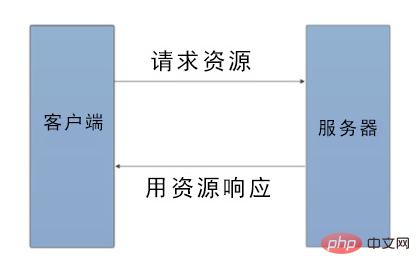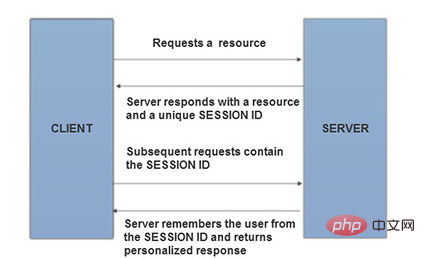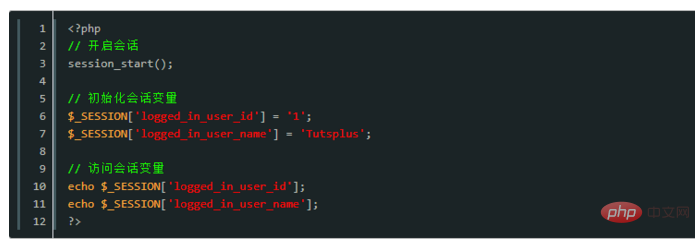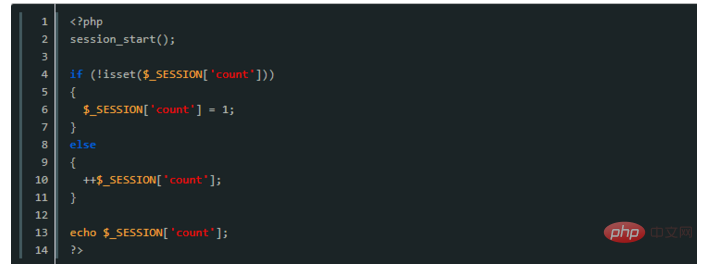Session processing in PHP (detailed code explanation)

Session handling is an important concept in PHP that allows user information to remain unchanged across all pages of a website or application. The following article will teach you the basic knowledge of session processing in PHP. I hope it will be helpful to you.
What is session in PHP?
Session is a mechanism that retains information on different web pages to identify users as they browse a website or application.
Everyone must have this question: Why does the website need sessions? Before discussing this issue, we need to go back and look at how the HTTP protocol works.
The HTTP protocol is a stateless protocol, which means that the server cannot remember a specific user between requests. For example, when you visit a web page, the server is only responsible for serving the content of the requested page. So when you visit other pages on the same website, the web server interprets each request individually as if they have nothing to do with each other. The server has no way of knowing that every request comes from the same user.
The following figure briefly describes the HTTP protocol.

In this process, if you want to display information about a specific user, you must authenticate the user in each request. Imagine if every time you make a request, you need to enter your username and password on the page for authentication; this is too cumbersome and not practical at all. However, session comes in handy at this time.
Session allows users to share information across different pages of a single site or application, so it helps maintain state. This lets the server know that all requests are coming from the same user, allowing the site to display user-specific information and preferences.
The following diagram describes how the HTTP protocol is used with sessions.

How does PHP handle sessions?
1. Start the session
Whenever you want to process session variables, you need to ensure that the session has been started. There are several ways to start a session in PHP.
1), use the session_start function
This is the most common method, in which the session is started by the session_start function.

It is important that the session_start function is called at the beginning of the script before any output is sent to the browser. Otherwise, you will encounter the infamous Headers are already sent error.
2), Automatically start the session
If you need to use the session throughout the application, you can also choose to automatically start the session without using the session_start function.
There is a configuration option session.auto_start in the php.ini file that allows us to automatically start a session for each request. By default, it is set to 0, we can set it to 1 to enable the auto-start feature.

2. Get the session ID
The server creates a unique id for each new session. If you want to get the session ID, you can use the session_id function as shown in the following snippet.

This should give you the current session ID. The session_id function is interesting because it can also take one parameter - a session ID. If you want to replace the system-generated session ID with your own, you can provide it to the first parameter of the session_id function.

It is important to note that when you want to start a session with a custom session ID, the session_id function must be called before session_start.
3. Create session variables
Once the session is started, $_SESSION will initialize the super-global array with the corresponding session information. By default it is initialized with a blank array, you can use key-value pairs to store more information.
Let’s take a look at how to initialize session variables through code examples.

As shown above, we use the session_start function to start a session at the beginning of the script; after that, we initialize several session variables; finally, we use The $_SESSION superglobal accesses these variables.
When using the $_SESSION superglobal to store data in a session, it is ultimately stored in the corresponding session file on the server that is created when the session is started. This way session data is shared across multiple requests.
As we discussed, session information is shared between requests, so session variables initialized on one page will also be accessible from other pages until the session expires. Normally, the session expires when the browser is closed.
4. Modify and delete session variables
We can modify or delete session variables previously created in the application just like modifying regular PHP variables.
Let’s take an example to see how to modify session variables.

In the above script, we first check whether the $_session['count'] variable is set. If it is not set, we will set it to 1, otherwise we will increment it by 1. So if you refresh this page multiple times, you can see the counter incrementing by one each time!
On the other hand, if you want to delete the session variable, you can use the unset function, as shown in the following code snippet:

In this way, we can no longer access the $_SESSION['logged_in_user_id'] variable. Because it has been deleted by the unset function.
5. Destroy the session
We know above that we can use the unset function to delete specific session variables; then if we want to delete all session-related data at once, we What to do?
It’s actually very simple, we can use the session_destroy function.
Let’s take a look at how the session_destroy function works.

Description: The session_destroy function deletes all content stored in the current session. Therefore, when the session data stored on disk is deleted by the session_destroy function, we will see an empty session variable from subsequent requests.
Note: Usually, the session_destroy function is used only when the user logs out
For more related PHP knowledge, please visit php tutorial!
The above is the detailed content of Session processing in PHP (detailed code explanation). For more information, please follow other related articles on the PHP Chinese website!

Hot AI Tools

Undresser.AI Undress
AI-powered app for creating realistic nude photos

AI Clothes Remover
Online AI tool for removing clothes from photos.

Undress AI Tool
Undress images for free

Clothoff.io
AI clothes remover

Video Face Swap
Swap faces in any video effortlessly with our completely free AI face swap tool!

Hot Article

Hot Tools

Notepad++7.3.1
Easy-to-use and free code editor

SublimeText3 Chinese version
Chinese version, very easy to use

Zend Studio 13.0.1
Powerful PHP integrated development environment

Dreamweaver CS6
Visual web development tools

SublimeText3 Mac version
God-level code editing software (SublimeText3)

Hot Topics
 1386
1386
 52
52
 PHP 8.4 Installation and Upgrade guide for Ubuntu and Debian
Dec 24, 2024 pm 04:42 PM
PHP 8.4 Installation and Upgrade guide for Ubuntu and Debian
Dec 24, 2024 pm 04:42 PM
PHP 8.4 brings several new features, security improvements, and performance improvements with healthy amounts of feature deprecations and removals. This guide explains how to install PHP 8.4 or upgrade to PHP 8.4 on Ubuntu, Debian, or their derivati
 How To Set Up Visual Studio Code (VS Code) for PHP Development
Dec 20, 2024 am 11:31 AM
How To Set Up Visual Studio Code (VS Code) for PHP Development
Dec 20, 2024 am 11:31 AM
Visual Studio Code, also known as VS Code, is a free source code editor — or integrated development environment (IDE) — available for all major operating systems. With a large collection of extensions for many programming languages, VS Code can be c
 7 PHP Functions I Regret I Didn't Know Before
Nov 13, 2024 am 09:42 AM
7 PHP Functions I Regret I Didn't Know Before
Nov 13, 2024 am 09:42 AM
If you are an experienced PHP developer, you might have the feeling that you’ve been there and done that already.You have developed a significant number of applications, debugged millions of lines of code, and tweaked a bunch of scripts to achieve op
 Explain JSON Web Tokens (JWT) and their use case in PHP APIs.
Apr 05, 2025 am 12:04 AM
Explain JSON Web Tokens (JWT) and their use case in PHP APIs.
Apr 05, 2025 am 12:04 AM
JWT is an open standard based on JSON, used to securely transmit information between parties, mainly for identity authentication and information exchange. 1. JWT consists of three parts: Header, Payload and Signature. 2. The working principle of JWT includes three steps: generating JWT, verifying JWT and parsing Payload. 3. When using JWT for authentication in PHP, JWT can be generated and verified, and user role and permission information can be included in advanced usage. 4. Common errors include signature verification failure, token expiration, and payload oversized. Debugging skills include using debugging tools and logging. 5. Performance optimization and best practices include using appropriate signature algorithms, setting validity periods reasonably,
 How do you parse and process HTML/XML in PHP?
Feb 07, 2025 am 11:57 AM
How do you parse and process HTML/XML in PHP?
Feb 07, 2025 am 11:57 AM
This tutorial demonstrates how to efficiently process XML documents using PHP. XML (eXtensible Markup Language) is a versatile text-based markup language designed for both human readability and machine parsing. It's commonly used for data storage an
 PHP Program to Count Vowels in a String
Feb 07, 2025 pm 12:12 PM
PHP Program to Count Vowels in a String
Feb 07, 2025 pm 12:12 PM
A string is a sequence of characters, including letters, numbers, and symbols. This tutorial will learn how to calculate the number of vowels in a given string in PHP using different methods. The vowels in English are a, e, i, o, u, and they can be uppercase or lowercase. What is a vowel? Vowels are alphabetic characters that represent a specific pronunciation. There are five vowels in English, including uppercase and lowercase: a, e, i, o, u Example 1 Input: String = "Tutorialspoint" Output: 6 explain The vowels in the string "Tutorialspoint" are u, o, i, a, o, i. There are 6 yuan in total
 Explain late static binding in PHP (static::).
Apr 03, 2025 am 12:04 AM
Explain late static binding in PHP (static::).
Apr 03, 2025 am 12:04 AM
Static binding (static::) implements late static binding (LSB) in PHP, allowing calling classes to be referenced in static contexts rather than defining classes. 1) The parsing process is performed at runtime, 2) Look up the call class in the inheritance relationship, 3) It may bring performance overhead.
 What are PHP magic methods (__construct, __destruct, __call, __get, __set, etc.) and provide use cases?
Apr 03, 2025 am 12:03 AM
What are PHP magic methods (__construct, __destruct, __call, __get, __set, etc.) and provide use cases?
Apr 03, 2025 am 12:03 AM
What are the magic methods of PHP? PHP's magic methods include: 1.\_\_construct, used to initialize objects; 2.\_\_destruct, used to clean up resources; 3.\_\_call, handle non-existent method calls; 4.\_\_get, implement dynamic attribute access; 5.\_\_set, implement dynamic attribute settings. These methods are automatically called in certain situations, improving code flexibility and efficiency.




